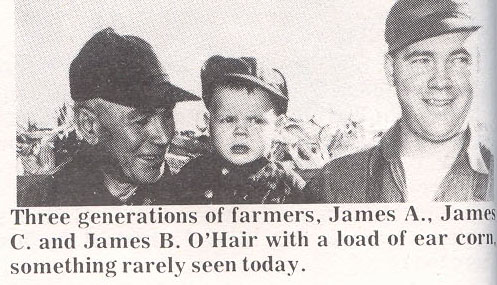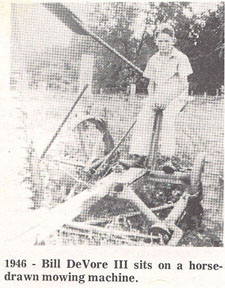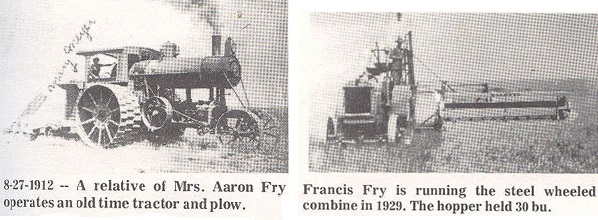

'A CENTURY OF MEMORIES'
1880 - 1980 |
|||||||||||||||||||||||||||||||||||||||||||||||||||||||||||||||||||||||||||||||||||||||||||||||||||
 |
|||||||||||||||||||||||||||||||||||||||||||||||||||||||||||||||||||||||||||||||||||||||||||||||||||
 Farmers
feed several families besides their own and in many cases, raise more on
10 acres than 40 acres would produce in 1880. Of course, there are fewer
farms now, although larger. O'Hairs, for example, now farm what used to
support 6 1/2 families. The Cox Farms, Inc. now farm what used to
support 20 or 21 families. It is interesting to note, though, that
several farms have remained virtually intact over the years. Several
century farms exist along with farmers of 50 years or more. A few of the
farmers of 1892 were as follows: J.E. Adams, George Arball, R.E.
Barackman, Samuel Barr, Oliver, Bassett, W.J. Blades, E.J. Blair, W.J.
Branscomb, Thomas Coffey, R.F. Craft, A.A. Dickinson, M. Dunslee, B.J.
Easter, B.F. Elston, E.M. Farrensworth, John Gemmill, F.L. Goin, William
Goodman, Fredrick Gould, L. Gould, N. Gould. J.F. Hacker, Grant
Hatfield, Lewis Holt, Peter Imhoff, W.A. Irving, J.H. Johnson, C.F.
Keller, S.H. Lantz, Stephen Lentz, L.T. Lee, George McCarl, Joshua
McCarl, McCartney, Mation Mace, A.C. Maxey, T.E. Owens, A.E. Pierce, G.
Pierce, J.W. Pierce, John Powers, Thomas Price, Jesse Roberts, L.F.
Roberts, W.T. Roberts, James Smith, J. Stearns, Isaiah Thompson. Farmers
feed several families besides their own and in many cases, raise more on
10 acres than 40 acres would produce in 1880. Of course, there are fewer
farms now, although larger. O'Hairs, for example, now farm what used to
support 6 1/2 families. The Cox Farms, Inc. now farm what used to
support 20 or 21 families. It is interesting to note, though, that
several farms have remained virtually intact over the years. Several
century farms exist along with farmers of 50 years or more. A few of the
farmers of 1892 were as follows: J.E. Adams, George Arball, R.E.
Barackman, Samuel Barr, Oliver, Bassett, W.J. Blades, E.J. Blair, W.J.
Branscomb, Thomas Coffey, R.F. Craft, A.A. Dickinson, M. Dunslee, B.J.
Easter, B.F. Elston, E.M. Farrensworth, John Gemmill, F.L. Goin, William
Goodman, Fredrick Gould, L. Gould, N. Gould. J.F. Hacker, Grant
Hatfield, Lewis Holt, Peter Imhoff, W.A. Irving, J.H. Johnson, C.F.
Keller, S.H. Lantz, Stephen Lentz, L.T. Lee, George McCarl, Joshua
McCarl, McCartney, Mation Mace, A.C. Maxey, T.E. Owens, A.E. Pierce, G.
Pierce, J.W. Pierce, John Powers, Thomas Price, Jesse Roberts, L.F.
Roberts, W.T. Roberts, James Smith, J. Stearns, Isaiah Thompson.Long Creek Township claims several Century Farms. George and Louisa J. (Fear) Redman purchased land in Section 35 from Stephen Strong in 1874. This land is owned now by the descendants of three of their children: (1) Frank and Cora (Redman) Binning to Bert and Elveta (Greenhalgh) Binning to Frank and Joyce (Andrew Binning.) (2) Benjamin F. and Jessie (Wilson) Redman to Horace and Wanda (Cole) Redman. (3) George and Carrie (Smith) Redman to Roland J. and Kathryn E. (Cochran) Redman. Samuel Smith bought land in Section 36 in 1863. George and Margaret (Sharpe) Smith (parents of Mrs. George (Carrie) Redman) bought this land in the early 1870's. Next owners, Guy Smith to George Redman and since 1938, Clyde and Margaret (Redman) Watson have been the owners. The farm now owned by Maurice H. and Leah F. Keeler in Greenbay Township was first purchased from the government in 1854 by William Steen and then sold to William McLlvaine the same year. In 1860, McLlvaine sold the Southwest 1/4, Section 31, Township 71, North Range 25, West of the 5th P.M., containing 160.53 acres to Benjamin F. Hall for the sum of $900.00. In 1891, the Des Moines and Kansas City railroad purchased the right-of-way 75 feet wide through this section. Later across the road in Franklin Township in Decatur County, 120 acres was added. In Section 6, Twp. 70, Range 25, 80 acres was added. (The rest in Section 6, Twp. 70 Range 26 in 40 acres.)  In
1919 the farm was transferred to C.E. Hall, son of Benjamin F. Hall.
Then in 1952, Maurice H. Keeler, a nephew of C.E. Hall inherited the
farm and Maurice and wife, Leah, are still residing there today. In
1919 the farm was transferred to C.E. Hall, son of Benjamin F. Hall.
Then in 1952, Maurice H. Keeler, a nephew of C.E. Hall inherited the
farm and Maurice and wife, Leah, are still residing there today.Still another farm which would qualify for the century farm listing is that now owned by Mrs. Jessie Lee and son Jimmie. Jack Lee's father, Harley, purchased the farm from his mother, Mrs. Agusta (Melcinda) Lee, in l936. Melcinda Ramsey inherited the land from her parents, Frank and Lavania Ramsey, who homesteaded in 1851, thus, the land has been in the family for 129 years. Another century farm in the Van Wert trade area is located in Knox township on the Clarke-Decatur County line. The farm was owned in about 1860 by Billa Brown. He was one of the early teachers in the Van Wert school. Mr. Brown was a great believer in conservation of soil and our natural resources. The farm was handed down to Uel Brown and then to Everett Brown and is still in the Brown family today. Farms in the Van Wert trading area that have been in the same family for 50 years or more in 1980 are: Dr. C.L. Wing Estate, J.B. and J.C. O'Hair, Russell and Dennis Fierce, Gerald Johnson, Amos to Dale West, J.E. Smith - Arta Smith - Fred Smith Jr., Bobby and Carroll Tompkins. Vernon Binning, Eldon Binning, Harry Jr. and David Wilson, Lloyd and Agnes McCarl, Fred and Ed Beers, W.B. Redman to Al Redman, Bob Redman, Cliff Redman, Ivan and Lilly Corsbie. |
|||||||||||||||||||||||||||||||||||||||||||||||||||||||||||||||||||||||||||||||||||||||||||||||||||
 |
|||||||||||||||||||||||||||||||||||||||||||||||||||||||||||||||||||||||||||||||||||||||||||||||||||
| Cox Farms, Inc. is a family farm corporation composed of Randal,
Darlene, Ted and Bill Cox. Their home farm is the only farmland owned by
the corporation but Randal does farm a total of 2,000 acres with the
help of his sons. Corwin Cox, a brother to Randal, farms approximately
1,200 acres each year, but is not part of the aforementioned
corporation. The primary crops of these two farmers are corn, beans and
hay with cattle being their only livestock. In 1964, Randal Cox built his initial dozer blades for farm tractors, and obtained his first U.S. Patent in 1965. As the business grew, it became necessary to form a corporation to keep the implement business separate from farming; thus, in 1966, Cox, Inc. was formed. In 1968, he built the Multi-Boom for tractors and the hay grabber for formed stack hay and loose hay. With the coming of the big bales, Randal made the trans-unroller to unroll along with the Hay Grabber to stack them. The "Hay Grabber" is Cox's U.S. Registered Trade Mark. They also make swivel booms and truck booms. Increased use of the big round bales and the desire of the farmer to chore with his pickup created the need for the cox pickup truck hay stabber and the three point stabber for tractors. They also make pickup and tractor trans-unrollers and have received a multiple of U.S. Patents for all these products. Their equipment is marketed all over the U.S. and Canada as well as being exported to Japan. At present, Cox's have a plant on their farm where they warehouse, assemble and ship their implements. Three to six men are employed at the plant. Cox's own designing and prototype is done at their plant and all products are tested on their farms before marketing. It is estimated that 25,000 to 103,000 units of the various implements have been made since 1964. Machinery reaches its destination by dealer pickup and Cox delivering. Some customers purchase and pick up equipment right from the plant. Each year they travel to the Iowa State Fair, where a lot of machinery is sold. What of the importance of the farmer to the Van Wert community of now vs. 1880? That has not changed. The businesses, churches, and organizations of the town still rely on him to keep things going directly or indirectly. Granted, good roads now carry them to other towns to shop and do business, but a good size of their trade remains in Van Wert, just as the roads carry in some commerce from distant communities. Farming and farm communities, which Van Wert is, have indeed changed. Evidence this in prices. In pioneer days, 10 cents/bushel corn would buy two good dinners in Van Wert. Now a bushel of corn could hardly buy one good meal. Below is a comparison of commodities and their price in 1880 and 1978 in Iowa: |
|||||||||||||||||||||||||||||||||||||||||||||||||||||||||||||||||||||||||||||||||||||||||||||||||||
|
|||||||||||||||||||||||||||||||||||||||||||||||||||||||||||||||||||||||||||||||||||||||||||||||||||
|
|||||||||||||||||||||||||||||||||||||||||||||||||||||||||||||||||||||||||||||||||||||||||||||||||||
| Sources: Basebook of Iowa -
Agricultural Economic Facts. April 1936 - Special Report No. 1, Iowa Agricultural Experiment. Iowa Agricultural Statistics, 1979 - Iowa Crop Livestock Reporting Service. |
|||||||||||||||||||||||||||||||||||||||||||||||||||||||||||||||||||||||||||||||||||||||||||||||||||
 The
spirit of farm people hasn't changed that much though. Despite numerous
hardships and uncertainty, they still hang on. If a neighbor becomes ill
or injured, and has planting or harvesting to be done, friends and
neighbors drop their own work to pitch in and get the job done. This is
reminiscent for some people of the threshing crew days when several
farmers got together to do the harvesting, each farm in turn, and the
ladies pooled their resources and talents to cook big meals for these
groups of hungry men. Some of that flavor is disappearing, but is never
lost from a small town farming community such as Van Wert. The
spirit of farm people hasn't changed that much though. Despite numerous
hardships and uncertainty, they still hang on. If a neighbor becomes ill
or injured, and has planting or harvesting to be done, friends and
neighbors drop their own work to pitch in and get the job done. This is
reminiscent for some people of the threshing crew days when several
farmers got together to do the harvesting, each farm in turn, and the
ladies pooled their resources and talents to cook big meals for these
groups of hungry men. Some of that flavor is disappearing, but is never
lost from a small town farming community such as Van Wert.Agriculture is a complex pursuit for the families of America. Those farmers of the Van Wert area, just as in other farming communities, are no exception to this, but they continue to take on the challenges of adverse weather, diseases, insects, high costs, relatively low and fluctuating prices and the ever fickle political nature of government programs. Though he now has got more to work with, the farmer has essentially fought these same problems for the past 100 years.  Let
us not forget as we celebrate the Van Wert centennial, the contributions
the farmers have made to this community. Where the railroads laid their
lines, the farmers came, and from their permanence on the land came the
rise and growth of towns like Van Wert. Let
us not forget as we celebrate the Van Wert centennial, the contributions
the farmers have made to this community. Where the railroads laid their
lines, the farmers came, and from their permanence on the land came the
rise and growth of towns like Van Wert.Let us not forget the challenges the farmer faces: the analysis of trends and issues, high land prices, the high costs of borrowed capital and physical inputs, production alternatives, technology and its application, public policies, organization and transfer of the business, and marketing problems and strategies, just to name a few. It is not just as simple as climbing on the tractor. But these challenges our farmers will meet, just as they have for the past 100 years all across our land. So shall it be in our centennial community of Van Wert! Since Van Wert was a farming community and the farmers had most of their money tied up in their farms, when the depression hit, many of the farmers had heavy loans on their farms and were to lose them since the bottom dropped out of all originally high prices they were getting for grain and cattle. E.O. Stearns worked diligently with the farm administration head offices to work out plans for the farmers to save their land. He was known to say, "Well, we got this through and ----- will not lose their farm and not have to move." Grandparents and Great Grandparents of this generation in Van Wert will remember the terribly trying times of the depression. Do you recognize a sarvus tree when you see one? If you go west of Van Wert in the early spring before a green leaf appears, the sarvus trees are the ones you see with the beautiful white blossoms up on the hills near the McKee Cemetery and other places. There is a legend told that the early pioneers transported these trees when they migrated from the State of Tennessee. It is true, that the same trees are very numerous in the Smoky Mountains in Tennessee. Spring time in the Tennessee Mountains, one can barely distinguish between the multitude of blossoms and the "smoky" part of the mountains. If you research these sarvus trees, you will find out that the name is really "service"; southern pronunciation turns the word to sarvus. History also states that they were the Indian's blueberry. Have the sarvus trees always grown in Decatur County? Is the transportation legend fact or fiction? Pages 26 - 30 |
|||||||||||||||||||||||||||||||||||||||||||||||||||||||||||||||||||||||||||||||||||||||||||||||||||
| Century of Memories Index *** History Index *** Decatur County IAGenWeb | |||||||||||||||||||||||||||||||||||||||||||||||||||||||||||||||||||||||||||||||||||||||||||||||||||